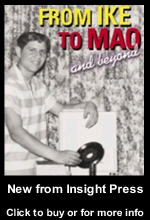
|
|||||||||||||||||||||
 |
|||||||||||||||||||||
 |
|
Bruce Gordon’s resignation as President (formerly called the Executive Director) of the NAACP “shocked the world” as Cassius Clay once said. It even shocked half the folks in the NAACP. It didn’t shock me, though. In my first book, Souls For Sale:The Diary of an Ex-Colored Man, which is about my experience as a young change activist in the NAACP in the 1980s, I entitled the first chapter of the book, “The Last Dinosaur…For Real". In my view, Gordon's resignation is just another case of “the Dinosaur” winning again. Gordon said the NAACP wasn’t a “fit” for him. Bruce Gordon is a change activist. No change activist is a fit for the NAACP. George Benson once sang, “Everything must change — nothing stays the same…”; George must never have been in the NAACP. Everything in the world changes, except the NAACP. I’m sure Bruce thought he could change the NAACP. Hell, we all thought that. One thing you discover once you get in is that the NAACP is change-resistant. You don’t know that if you’ve never served in the NAACP, or tried to make a change in the NAACP. In fact, you can’t know the NAACP if you’ve never been in the NAACP. Most people join the NAACP, which means writing a check, and a small one, at that. Few people have ever done any advocacy work in an NAACP branch. Joining the NAACP is a lot different than working in the NAACP. Bruce Gordon probably didn’t know that. He knows now. Let’s examine this in its proper context. The NAACP is the “holy grail” of the civil rights community. People bow, and whisper its name and cross their breast in deference to its biggest accomplishment, overturning “Separate But Equal” de jure segregation in the case of Brown v. Board of Education. There are two important things to note here. Firstly, it was the NAACP's Legal Defense and Education Fund (a separate organization) that won Brown, and not the NAACP. Nonetheless, because the NAACP seeded (help secure funding) the LDF and had oversight in its first thirty years, the NAACP gets all the credit and the NAACP Legal Defense Fund (which separated permanently from the NAACP in the 1970s) gets hardly any. Secondly, Brown did not end Jim Crow, it just provided the legal sanction to end it. The SCLC-inspired Civil Rights Movement, led by Dr. Martin Luther King, Jr., fought the ten year Massive Resistance to Brown in the streets, with direct-action non-violent protest. The NAACP and its leadership (the organization, Roy Wilkins, the LDF, and Thurgood Marshall) vehemently disagreed with Dr. King's tactics. However, since the NAACP was banned in Alabama, for refusing to turn over its membership lists, King came to national prominence for his work in challenging the segregation laws in Alabama (Montgomery, Birmingham and Selma). Excuse my digression… but it is significant to point out that the NAACP was there, but largely in the courts. Since 1968, the year of Dr. King’s murder and by most historical accounts, the end of the civil rights movement, the NAACP has had a minimal role in changing anything in the civil rights arena. In fact, during the most damaging period of the Post Civil Rights Era, the Reagan Revolution of 1980-1992, the NAACP essentially was silent. Twice, the Rev. Jesse Jackson had to run for President, and Minister Louis Farrakhan had to attack the system for Black civil and economic concerns to be heard.
Today, however, all express eternal gratitude to the NAACP, even though the organization has become irrelevant in the contemporary civil rights movement. The sentimentality associated with the NAACP is unheralded. People cry at conventions and Image Awards, eternally grateful for the work of the NAACP — work that was done 50 years ago — without really understanding the work that isn’t getting done today. That’s why Black people are now in worse condition, both economically and socially than they were 30 years ago. It’s almost sacrilegious to speak against the NAACP. Criticism, however, is the first step toward self-improvement. Nothing exempt from critique improves. The NAACP’s organizational structure and advocacy approach are antiquated, yet they refuse to change. What changes have been made haven’t been for the better. The NAACP’s “bread and butter” was its presence in the courts, and yet the NAACP rarely sues anymore. The greatest economic reciprocity program, "Fairshare", developed by the NAACP in the 1970s, has been phased out. Everybody has a corporate social responsibility and accountability program, except the NAACP. When Ben Hooks, the civil rights era leader and republican who refused to attack Reagan, left, it was said that the NAACP needed a “youth transfusion". Ben Chavis was hired, brought in thousands of youth but was forced out under a cloud of economic and sexual improprieties. Most younger members left with him. Kweisi Mfume came in, declaring the NAACP needed to be restructured. He believed it had too many board members (64) and too many branches (2,200). When he left, nine years later, it had the same number of board members and more branches (now 2,500). Then Gordon came in, trying to find a new advocacy niche. Social services would, of course, make the NAACP eligible for foundation money and larger corporate dollars, however, NAACP Board Chair, Julian Bond, a vestige of the civil rights era, said, “The NAACP doesn’t do social services. We do civil rights." Since when, 1954? Okay, 1964. Don’t misunderstand me; I respect the NAACP. I’ve consulted to the NAACP in my post-presidency years (1992-1995). I support the NAACP on some fronts (ACT-SO, Image Awards). I just know there are some things I can’t expect from the NAACP, and change is one of them.
The NAACP is not only a dinosaur, it’s a two-headed dinosaur, led by a President and a Board Chair that have paralyzed the organization since the Ben Hooks-Margaret Bush Wilson battles of the 1970s. For the last 30 years, the NAACP Board Chair and its Chief Executive (Executive Director, now the President) have rarely been on the same page. And as for the defining moments in Black America for the past thirty years, the NAACP is mostly on the wrong side. It didn’t support Jesse for President in 1984. It didn’t speak out against the Clarence Thomas nomination in 1991. It was one of two major Black organizations that didn’t support the Million Man March in 1995. The National Baptist Convention was the other, which is the same group that kicked King out of their convention in 1961. It has refused to call boycotts against major discriminators for the past 20 years and that has had devastating effects on the Black economy. A “report card” is the best we get out of the NAACP. SCLC called for more boycotts in their first five years than the NAACP has in almost 100 years. Now, the organization has resisted the latest effort to make the NAACP relevant. Bruce Gordon found out that the NAACP Board still likes to micro-manage. He’d change before the NAACP would. So he quit, and he’s not the first, nor will he be the last. I’d like to offer a correction what Julian Bond said. Its not that the NAACP doesn’t do social services; what Julian Bond should have said was that The NAACP doesn’t do change. Of course, there is no way to know that unless you’ve tried to change the NAACP. Now Bruce Gordon knows. BC columnist Anthony Asadullah Samad is a national columnist, managing director of the Urban Issues Forum and author of the upcoming book, Saving The Race: Empowerment Through Wisdom. His Website is www.AnthonySamad.com. Click here to contact Mr. Samad. |
|
| Home | |
| March
15, 2007 Issue 221 |
||||||||||||||
|
||||||||||||||
| Printer Friendly Version in resizeable plain text format | ||||||||||||||
 |
||||||||||||||
|
||||||||||||||
 |
||||||||||||||
 |
||||||||||||||
 |
||||||||||||||
| |
||||||||||||||
| |
||||||||||||||






























